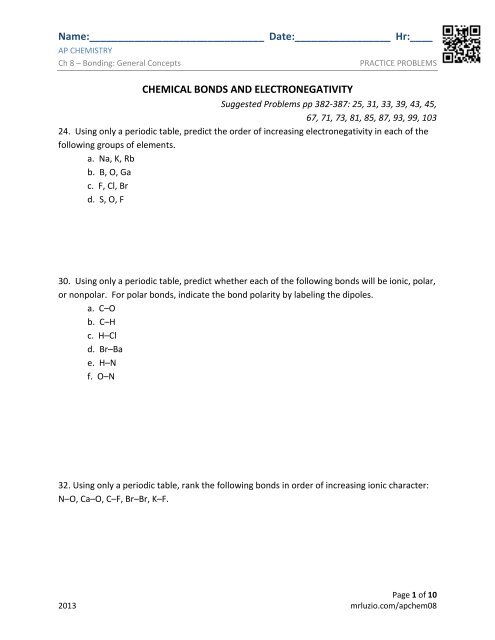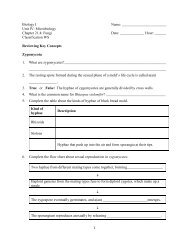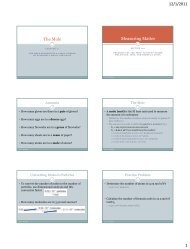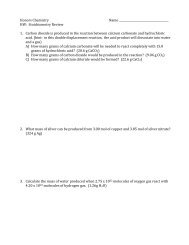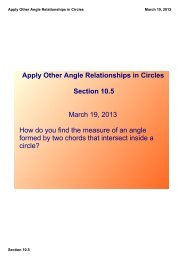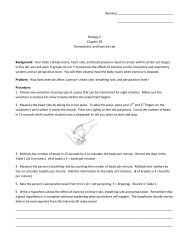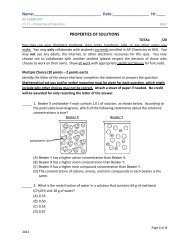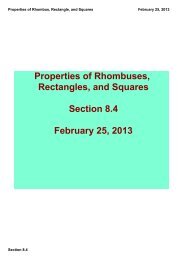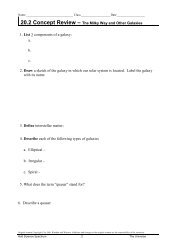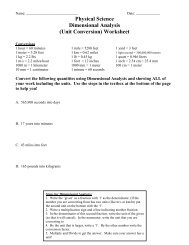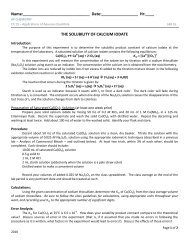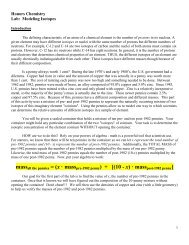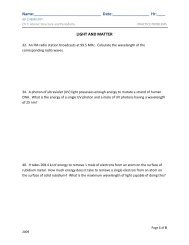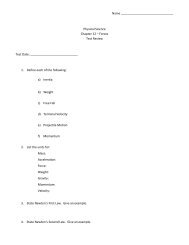Ch 8 Practice Problems - AP Chemistry
Ch 8 Practice Problems - AP Chemistry
Ch 8 Practice Problems - AP Chemistry
Create successful ePaper yourself
Turn your PDF publications into a flip-book with our unique Google optimized e-Paper software.
Name:_______________________________ Date:_________________ Hr:____<br />
<strong>AP</strong> CHEMISTRY<br />
<strong>Ch</strong> 8 – Bonding: General Concepts<br />
PRACTICE PROBLEMS<br />
CHEMICAL BONDS AND ELECTRONEGATIVITY<br />
Suggested <strong>Problems</strong> pp 382-387: 25, 31, 33, 39, 43, 45,<br />
67, 71, 73, 81, 85, 87, 93, 99, 103<br />
24. Using only a periodic table, predict the order of increasing electronegativity in each of the<br />
following groups of elements.<br />
a. Na, K, Rb<br />
b. B, O, Ga<br />
c. F, Cl, Br<br />
d. S, O, F<br />
30. Using only a periodic table, predict whether each of the following bonds will be ionic, polar,<br />
or nonpolar. For polar bonds, indicate the bond polarity by labeling the dipoles.<br />
a. C–O<br />
b. C–H<br />
c. H–Cl<br />
d. Br–Ba<br />
e. H–N<br />
f. O–N<br />
32. Using only a periodic table, rank the following bonds in order of increasing ionic character:<br />
N–O, Ca–O, C–F, Br–Br, K–F.<br />
Page 1 of 10<br />
2013 mrluzio.com/apchem08
Name:_______________________________ Date:_________________ Hr:____<br />
<strong>AP</strong> CHEMISTRY<br />
<strong>Ch</strong> 8 – Bonding: General Concepts<br />
IONS AND LATTICE ENERGY<br />
PRACTICE PROBLEMS<br />
40. For each of the following groups, place the atoms and/or ions in order of decreasing size.<br />
a. V, V 2+ , V 3+ , V 5+<br />
b. Na + , K + , Rb + , Cs +<br />
c. Te 2- , I - , Cs + , Ba 2+<br />
d. P, P - , P 2- , P 3-<br />
e. O 2- , S 2- , Se 2- , Te 2-<br />
44. Which compound in each of the following pairs of ionic substances has the most<br />
exothermic lattice energy Justify your answers.<br />
a. LiF, CsF<br />
b. NaBr, NaI<br />
c. BaCl 2 , BaO<br />
d. Na 2 SO 4 , CaSO 4<br />
e. KF, K 2 O<br />
f. Li 2 O, Na 2 S<br />
Page 2 of 10<br />
2013 mrluzio.com/apchem08
Name:_______________________________ Date:_________________ Hr:____<br />
<strong>AP</strong> CHEMISTRY<br />
<strong>Ch</strong> 8 – Bonding: General Concepts<br />
46. Use the following data to estimate for magnesium fluoride.<br />
Mg(s) + F 2 (g) MgF 2 (s)<br />
PRACTICE PROBLEMS<br />
Lattice energy<br />
First ionization energy of Mg<br />
Second ionization energy of Mg<br />
Electron affinity of F<br />
Bond energy of F 2<br />
Enthalpy of sublimation of Mg<br />
-3916 kJ/mol<br />
735 kJ/mol<br />
1445 kJ/mol<br />
-328 kJ/mol<br />
154 kJ/mol<br />
150. kJ/mol<br />
48. Compare the electron affinity of fluorine to the ionization energy of sodium. Is the process<br />
of an electron being “pulled” from the sodium atom to the fluorine atom exothermic or<br />
endothermic Why is NaF a stable compound Is the overall formation of NaF endothermic or<br />
exothermic How can this be<br />
52. The lattice energies of FeCl 3 , FeCl 2 , and Fe 2 O 3 are (in no particular order) -2631, -5359, and<br />
-14,774 kJ/mol. Match the appropriate formula to each lattice energy. Explain.<br />
Page 3 of 10<br />
2013 mrluzio.com/apchem08
Name:_______________________________ Date:_________________ Hr:____<br />
<strong>AP</strong> CHEMISTRY<br />
<strong>Ch</strong> 8 – Bonding: General Concepts<br />
PRACTICE PROBLEMS<br />
LEWIS STRUCTURES AND RESONANCE<br />
68. Write Lewis structures that obey the octet rule for each of the following molecules and<br />
ions. (In each case the first atom listed is the central atom.)<br />
a. POCl 3<br />
b. SO 4<br />
2-<br />
c. XeO 4<br />
d. PO 4<br />
3-<br />
e. ClO 4<br />
-<br />
f. NF 3<br />
g. SO 3<br />
2-<br />
h. PO 3<br />
3-<br />
i. ClO 3<br />
-<br />
j. ClO 2<br />
-<br />
68.5. What conclusions can you draw concerning structures of species containing the same<br />
number of atoms and the same number of valence electrons<br />
Page 4 of 10<br />
2013 mrluzio.com/apchem08
Name:_______________________________ Date:_________________ Hr:____<br />
<strong>AP</strong> CHEMISTRY<br />
<strong>Ch</strong> 8 – Bonding: General Concepts<br />
PRACTICE PROBLEMS<br />
72. SF 6 , ClF 5 , and XeF 4 are three compounds whose central atoms do not follow the octet rule.<br />
Draw Lewis structures for these compounds.<br />
74. Some of the important pollutants in the atmosphere are ozone (O 3 ), sulfur dioxide, and<br />
sulfur trioxide. Write Lewis structures for these three molecules. Show all resonance<br />
structures where applicable.<br />
80. Order the following species with respect to carbon-oxygen bond length (longest to<br />
shortest): CO, CO 2 , CO 3 2- , CH 3 OH<br />
80.5. What is the order from the weakest to the strongest carbon-oxygen bond<br />
Page 5 of 10<br />
2013 mrluzio.com/apchem08
Name:_______________________________ Date:_________________ Hr:____<br />
<strong>AP</strong> CHEMISTRY<br />
<strong>Ch</strong> 8 – Bonding: General Concepts<br />
PRACTICE PROBLEMS<br />
FORMAL CHARGE<br />
82. Determine the Lewis structures that involve minimum formal charges for each of the<br />
following species.<br />
a. POCl 3<br />
b. SO 4<br />
2-<br />
c. ClO 4<br />
-<br />
d. PO 4<br />
3-<br />
e. SO 2 Cl 2<br />
f. XeO 4<br />
g. ClO 3<br />
-<br />
h. NO 4<br />
3-<br />
Page 6 of 10<br />
2013 mrluzio.com/apchem08
Name:_______________________________ Date:_________________ Hr:____<br />
<strong>AP</strong> CHEMISTRY<br />
<strong>Ch</strong> 8 – Bonding: General Concepts<br />
PRACTICE PROBLEMS<br />
84. Oxidation of the cyanide ion produces the stable cyanate ion, OCN - . The fulminate ion,<br />
CNO - , on the other hand, is very unstable. Fulminate salts explode when struck; Hg(CNO) 2 is<br />
used in blasting caps. Write the Lewis structures and assign formal charges for the cyanate and<br />
fulminate ions. Why is the fulminate ion so unstable (C is the central atom in OCN - and N is<br />
the central atom in CNO - )<br />
Page 7 of 10<br />
2013 mrluzio.com/apchem08
Name:_______________________________ Date:_________________ Hr:____<br />
<strong>AP</strong> CHEMISTRY<br />
<strong>Ch</strong> 8 – Bonding: General Concepts<br />
MOLECULAR STRUCTURE AND POLARITY<br />
PRACTICE PROBLEMS<br />
88.Predict the molecular structure and bond angles for each molecule or ion in #68 (p 4) and<br />
#82 (p 6).<br />
Page 8 of 10<br />
2013 mrluzio.com/apchem08
Name:_______________________________ Date:_________________ Hr:____<br />
<strong>AP</strong> CHEMISTRY<br />
<strong>Ch</strong> 8 – Bonding: General Concepts<br />
PRACTICE PROBLEMS<br />
1. Account for the following statements or observations in terms of atomic-level, ionic-level,<br />
or molecular-level explanations.<br />
a. Magnesium exists as 2+ ions rather than 1+ ions in all its compounds despite the fact<br />
that the second ionization energy of a magnesium atom is more than twice as great<br />
as the first ionization energy. Use lattice energy as the basis for your explanation.<br />
b. Titanium forms ions with different charges (+2, +3, and +4). The first two of these<br />
ions are colored while the last is colorless. Visible color typically corresponds to<br />
electronic transitions.<br />
c. A molecule of nitrogen has a shorter bond length than does a molecule of fluorine<br />
even though the fluorine atom has a smaller radius.<br />
d. Nitrogen forms NF 3 but not NF 5 whereas phosphorus forms PF 3 and PF 5 . The<br />
trifluorides are both polar and the pentafluoride is non-polar.<br />
Page 9 of 10<br />
2013 mrluzio.com/apchem08
Name:_______________________________ Date:_________________ Hr:____<br />
<strong>AP</strong> CHEMISTRY<br />
<strong>Ch</strong> 8 – Bonding: General Concepts<br />
118. Given the following information:<br />
PRACTICE PROBLEMS<br />
Heat of sublimation of Li(s)<br />
Bond energy of HCl<br />
Ionization energy of Li(g)<br />
Electron affinity of Cl(g)<br />
Lattice energy of LiCl(s)<br />
Bond energy of H 2<br />
166 kJ/mol<br />
427 kJ/mol<br />
520. kJ/mol<br />
-349 kJ/mol<br />
-829 kJ/mol<br />
432 kJ/mol<br />
Calculate the net change in energy for the following reaction:<br />
2 Li(s) + 2 HCl(g) 2 LiCl(s) + H 2 (g)<br />
Page 10 of 10<br />
2013 mrluzio.com/apchem08


